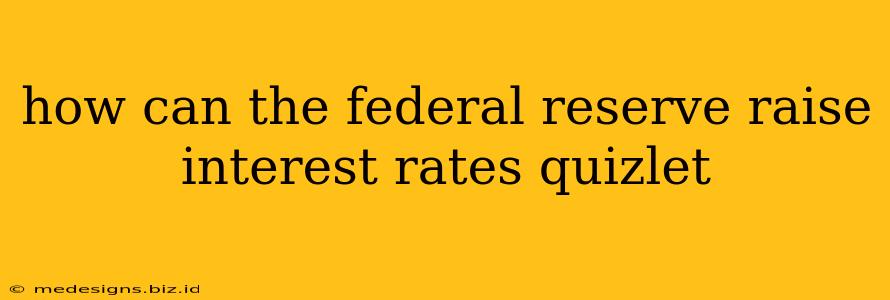How Can the Federal Reserve Raise Interest Rates? A Comprehensive Guide
The Federal Reserve (also known as the Fed), the central bank of the United States, plays a crucial role in managing the nation's economy. One of its key tools is the ability to raise interest rates. But how does it actually do this? This guide will break down the mechanisms the Fed employs, answering the question: How can the Federal Reserve raise interest rates?
Understanding the Federal Funds Rate
The most important tool the Fed uses is the federal funds rate. This is the target rate that the Fed wants banks to charge each other for overnight lending of reserves. It's not a rate directly set by the Fed; rather, it's a target rate influenced by the Fed's actions.
The Fed doesn't directly lend to commercial banks on a day-to-day basis. Instead, it influences the federal funds rate through open market operations.
Key Mechanisms the Fed Employs:
-
Open Market Operations (OMO): This is the primary method. When the Fed wants to raise interest rates, it sells government securities (like Treasury bonds) to commercial banks. This reduces the amount of reserves banks hold. With fewer reserves, banks are less willing to lend to each other at lower rates, pushing the federal funds rate upward. Think of it like supply and demand – less supply of reserves (money) leads to higher demand and therefore higher prices (interest rates).
-
Discount Rate: The discount rate is the interest rate at which commercial banks can borrow money directly from the Federal Reserve. By raising the discount rate, the Fed makes borrowing more expensive for banks. This discourages borrowing and helps to constrain the money supply, indirectly pushing up the federal funds rate. This is a less frequently used tool than open market operations.
-
Reserve Requirements: Banks are required to hold a certain percentage of their deposits as reserves. By increasing the reserve requirement, the Fed reduces the amount of money banks can lend out, thus tightening credit conditions and contributing to higher interest rates. Changes to reserve requirements are less frequent because they can have a more significant and abrupt impact on the economy.
-
Interest on Reserves (IOR): The Fed pays interest on the reserves that banks hold at the Federal Reserve. By increasing the IOR, the Fed makes it more attractive for banks to hold reserves, reducing the amount available for lending and putting upward pressure on interest rates. This is a relatively newer tool but has become increasingly important.
The Ripple Effect: How Rate Hikes Impact the Economy
Raising the federal funds rate doesn't just affect banks. It has a wider ripple effect throughout the economy:
- Higher borrowing costs: Consumers and businesses face higher interest rates on loans, mortgages, and credit cards. This can reduce spending and investment.
- Slower economic growth: Reduced borrowing and spending can lead to slower economic growth, potentially helping to curb inflation.
- Stronger dollar: Higher interest rates can attract foreign investment, leading to a stronger US dollar. This can make imports cheaper but exports more expensive.
In conclusion, the Federal Reserve utilizes a range of tools, primarily open market operations, to raise interest rates. These actions aim to manage inflation and maintain overall economic stability, though they can have various impacts on different sectors of the economy. Understanding these mechanisms is vital for comprehending the complexities of monetary policy.
